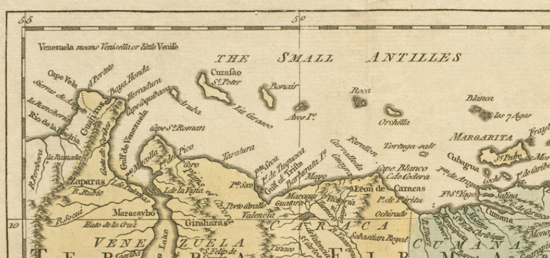There was curaçao in 1814?

Yes indeed there was, though not the brand name we know now, that didn’t come along in the late 1800’s. Curaçao, originally, was a generic term for orange-infused brandies that were originally produced by the Dutch. The Dutch owned, and indeed still do own, the island of Curaçao which is located in a chain of islands called the “Lesser Antilles” just off the coast of Venezuela. There an odd variety of citrus known as the “laraha” grows. It’s a descendant of the Valencia orange, originally brought to Curaçao by the Spaniards in the 1500’s but which, due to the island’s relatively poor soil, soon evolved (devolved?) into something else. That thing is the laraha, a small, green, bitter and thick-skinned citrus that just happens to be terrible for eating but great for flavoring alcohol.
The Dutch, being canny traders, were quick to pick up on that fact. They brought larahas home to the Netherlands by the shipload, where they steeped them in brandy along with other spices collected from the Carribbean. “Curaçao” was the result, and it was all the rage in Carême’s day. So much so that he incorporated it into his (then) very trendy “strawberries Romanoff”. How popular was curaçao back then? Let’s just say that it wasn’t long after Carême seized on this hot new ingredient that a fellow named Jean-Baptiste Combier created France’s first orange-flavored liqueur, then known simply as “Combier”. It was such a smash that he shortly launched another orange-infused product he called “Curaçao triple sec”. We of course know it today as simply “triple sec”.
Seeing Combier’s success, a candy and spirits maker by the name of Adolphe Cointreau decided he’d better get into the orange liqueur game as well. He called his creation “Curaçao Blanco Triple Sec de Cointreau”, a name he’d later simplify, much to the delight of his label designer. Here I should insert that there was a fundamental difference between French curaçao and Dutch curaçao. Where the Dutch used brandy as a base, the French used a neutral clear alcohol that was fermented from sugar beets. Today triple sec, Cointreau and Curaçao (the brand name liqueur produced on the island itself) all use neutral clear spirits as a base.
Which raises the question: was Carême’s curaçao based on brandy or sugar beet alcohol? My guess, since strawberries Romanoff was created at least 15 years — and as many as 25 years — before Combier ever hit the market, Carême probably used the Dutch stuff. Which means his liqueur was closer to Grand Marnier (an orange-flavored brandy) than any curaçao we know today. I’ll leave it to you to decide which one is truer to the spirit (no pun intended) of Carême’s recipe.